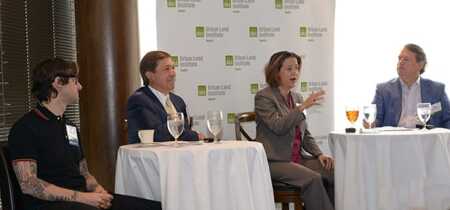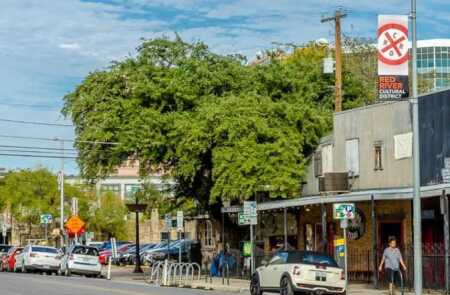Austin relishes its self-proclaimed status as the “Live Music Capital of the World,” and the Texas capital benefits not only culturally but also economically from music-fueled gatherings such as the South by Southwest festival and the Austin City Limits Music Festival (ACL).
Yet neither the Live Music Capital of the World nor the annual festivals would exist without the everyday local music scene — populated by hundreds of Austin musicians who, in many cases, are barely scraping by. And those local musicians, in turn, would not even be scraping by without the live music venues that buttress them.
At a session hosted by ULI Austin, panelists reviewed efforts to save what John McKinnerney, founding principal of Austin commercial real estate investment firm Castle Hill Partners, characterized as “a very fragile ecosystem” of Austin’s live music venues and the musicians who perform there. McKinnerney chaired a Technical Assistance Program panel (TAP) that was tasked by the city of Austin’s Economic Development Department with analyzing the ongoing viability of the music-powered Red River Cultural District.
Amid rising venue rents, housing affordability woes, and ever-present construction cranes in Austin, local music venues—and, therefore, local musicians—fear extinction. This is of particular concern in downtown Austin’s Red River Cultural District, dotted with more than a dozen relatively small music venues that continue to be enveloped by the city’s population and construction boom.
“We won’t be the Live Music Capital of the World if we don’t have live music,” TAP member Christine Maguire, manager of the city of Austin’s redevelopment division, told attendees at the ULI breakfast.
And if that were to happen, the Austin economy likely would also suffer. In 2016, the city’s music industry carried an economic impact of $1.8 billion.
But even as those dollars keep rolling in—in part due to music-related tourism—TAP participant Cody Cowan, general manager of the Mohawk music venue on Red River and director of the one-year-old Red River Merchants Association, lamented that the state of the local music scene is “tenuous.”

From left to right: Cody Cowan, general manager of the Mohawk; Dan Wheelus, attorney and executive advisory board member of the Texas Heritage Songwriter’s Association; Christine Maguire, redevelopment division manager, city of Austin; and John McKinnerney, Castle Hill Partners and chair of the ULI TAP panel, speaking at a ULI Austin breakfast panel.
“While it’s not profitable, if you were to remove local music, you would remove the draw for South by Southwest and ACL,” Cowan said. “You remove anything other than these megastars [who] are touring through, then the whole industry itself falls out and then we’ve got a situation that none one came to Austin or fell in love with Austin for.”
The Red River Cultural District, created by the Austin City Council in 2013, is an entertainment zone along and around Red River Street that stretches from Austin’s famed Sixth Street to 12th Street. The district functions as an incubator for local musicians to hone their craft and serves as an entertainment destination for visitors and locals alike.
That district is in danger, according to a report issued recently by the TAP. Many of the 13 Red River music venues—including the critically acclaimed Stubb’s and Mohawk clubs—“are vulnerable to being replaced or severely impacted by new commercial development and/or unpredictable, unaffordable rents,” the report says.
Advocates of the Red River district emphasize that it is home to the only remaining cluster of live music venues that showcase local musicians and that sit within the central part of downtown Austin.
“We’re dealing with the stress and strain of a town that is becoming more and more elitist every day, and yet we cherish these young songwriters and we cherish the musicians,” said Austin attorney Dan Wheelus, a member of the Red River TAP who has been helping local residential real estate titan Gary Keller preserve the Austin music scene. “How do we keep this all working together? That is the bottom line of what we are talking about.”
In the report, Wheelus and other TAP members put forth recommendations for several short-term solutions to the problems plaguing the Red River district. Those include:
-
- Reducing crime and improving safety along the Red River corridor.
- Addressing the presence of crooks and homeless people who make the area “unpleasant” for visitors due to drug use, prostitution, and other unsavory activities.
- Ensuring that developers and residents in the vicinity are “aware and accepting of” noise produced by existing music venues.
- Streamlining the city’s permitting and licensing process.
- Exploring public and public/private efforts to preserve music venues.
- Making the Red River streetscape more attractive and introducing more daytime activities.
Wheelus raised the daunting prospect that over the long term, property values in the Red River area will skyrocket as work proceeds on the Waller Creek tunnel project, further squeezing the district’s music venues. The project is expected to open up flood-prone land for massive development of office, residential, retail, and hotel space.
Maguire said that pushing live music venues to Austin suburbs like Pflugerville and Kyle is not a workable approach to tackling the issue of sharply rising property values in the Red River corridor, as that would weaken Austin’s standing as “an inclusive economy.”
Rather, she said, land use regulations, financial incentives, and “robust” policies and tools must be fashioned to unlock public and private capital that will bolster local music venues.
Striking a hopeful tone, Cowan said that momentum regarding the plight that confronts local music venues is “on the right track.”
“Something we’ve found is there’s no magic bullet, there’s no magic wand,” he said. “Complex problems require complex solutions, multipronged solutions.”





